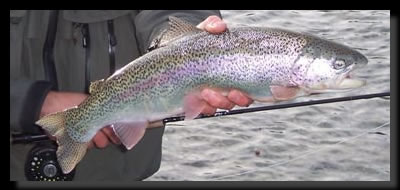
 |
| Rainbow Trout (Oncorhynchus mykiss) |
 |
|
Alaska's rainbows are world famous for their size and fight. They are plentiful in most rivers and creeks and they are a very aggressive game fish. Overfishing has lead to depleted poulations in many popular fishing areas, but recent efforts to protect and preserve these fisheries has led to healthy rebounds in most areas. The Susitna River drainage is home to a very healthy rainbow population and the small river and creek fishing for these trophy rainbows is unparalleled. Physical Description: Black spots on sides and back, and on dorsal and anal fins; reddish band along the side; smaller than the sea-run rainbows also known as steelhead. Tactics: Rainbows prefer cold water. In the spring when water temps are lower you can find them closer to shore. As water temps rise them move to deeper holes and runs. Being an aggressive fish, they will respond well to spinners and spoons and all manner of fly tackle. Leech, smolt, flesh and even mouse, that is right, mouse patterns are very effective and various shades of egg imitations often take the biggest fish. State Record: 42 pounds, 3 ounces in 1970 |
| Dolly Varden (Salvelinus malma) |
 |
|
Dolly Varden, or Bull Trout, are a near cousin of the rainbow and equally as aggressive. They have a much larger mouth and they are a very predatorial fish. They frequent much of the same water as rainbows, but often prefer slightly slower water. Look for them in slower currents that form feeding slots and troughs. Physical Description: Generally mottled olive-brown color, but the sea run variety tends to be dark blue or green on the back with silver sides. Both varieties have a red stripe and red, orange, or yellow spots on the back and sides. Average mature weight is 2-3 pounds. Tactics: As with rainbows, spinner and spoons work well as does anything shiny that might resemble bait fish. On the fly, nymphs, streamers, leaches, and flies with a lot of flash work well. State Record: 27 pounds 6 ounces (2002) |
| Arctic Grayling (Thymallus arcticus) |
 |
|
The Grayling is the subtle but lively gem of the far north. At times they can be finicky and difficulty to catch, but for the most part they are a willing subject and rise to all manner of fly gear and light spinning tackle. They are found throughout the lakes and rivers of Southcentral, the Interior and northern Alaska. Physical Description: Tactics: Small flies including egg patterns and dry's that match the hatch. Small lures such as Panther Martin's or Rooster Tails in dark colors are very effective. State Record: 4 pounds 13 ounces (1981) |